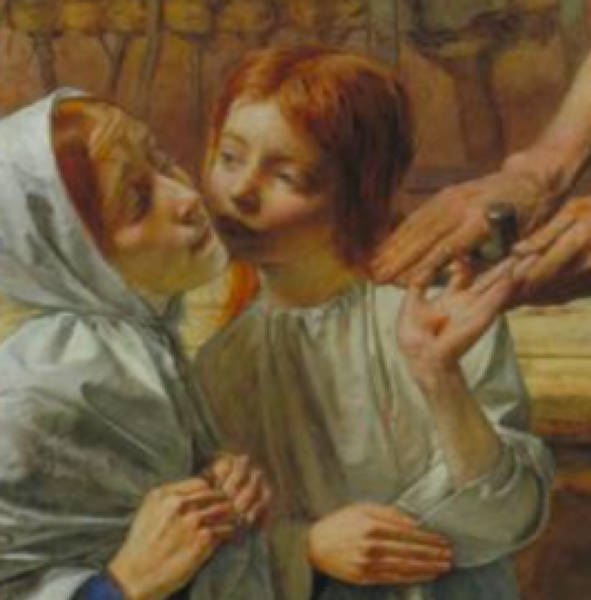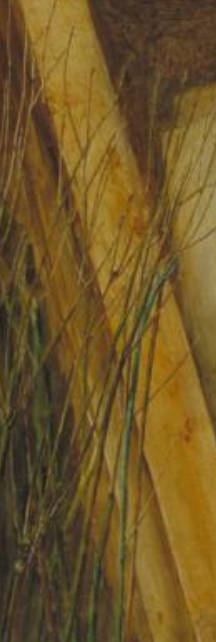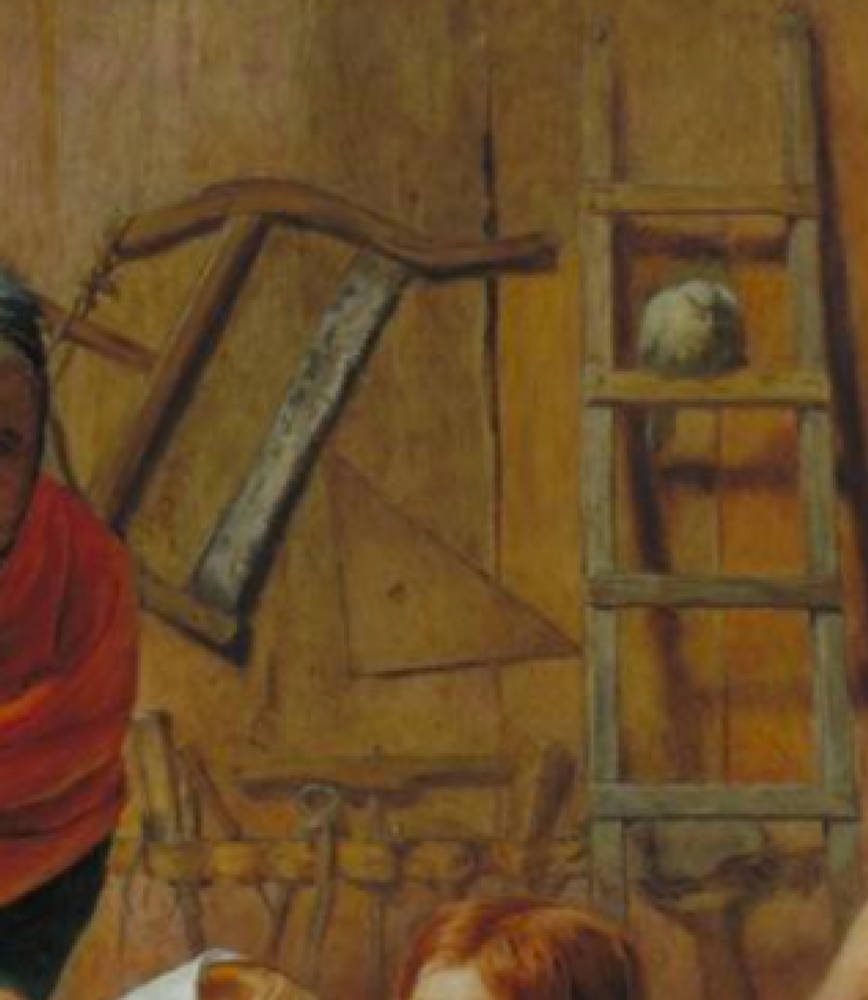
John Everett Millais. Christ in the House of His Parents. 1849-50. Oil on canvas, 34 x 55 inches; 864 x 1397 mm. Tate Britain, London. N03584. Purchased with assistance from the Art Fund and various subscribers 1921. Image released under Creative Commons CC-BY-NC-ND. Click on image to enlarge it.

Millais's Christ in the House of His Parents (1850) and Hunt's The Finding of the Saviour in the Temple (1854-60) exemplify the early Pre-Raphaelite use of typology as a basis for symbolic realism. Millais, who was inspired by a High Anglican sermon in Oxford to paint his picture, provides an instance of Tractarian use of such symbolism, for his representation of an imagined event from the life of Jesus serves as an image of Christ as priest and sacrifice. The painter has represented the boy Christ immediately after He has wounded Himself trying to remove a nail from a board with pincers, and this event, like the cornerstone in Tintoretto's Annunciation, turns the coarse details of genre painting into spiritual fact. Jesus, whom Mary comforts, holds up His hand so that both Joseph and the spectator can see His wound. The blood on His wounded palm and that which has dropped upon His foot presents a prefigurative image of both the Crucifixion and the resurrected Christ presenting Himself to the eye of faith in the form of the Man of Sorrows. Compare, for instance, Albrecht Dürer's Man of Sorrows with Hands Raised [c. 1500], an engraving upon which Hunt may have drawn in designing The Shadow of Death. According to him, he and his friends studies such earlier engravings in the British Museum Print Room, and so he and Millais would have encountered various versions of this subject. The Jesus holds his left hand in precisely the same position as Dürer’s Man of Sorrows.
Many of the details in Christ in the House of His Parents also prefigure the passion and death of Christ and thus reinforce the meaning of the picture's central image. The pincers and nail toward which Anne extends her hand are emblems of the Crucifixion, and the carpenter's tools and ladder on the wall behind Jesus also remind us of this event. Similarly, John's coming to Christ with a bowl of water probably serves as loose types of Christ's baptism and also of the vinegar and gall offered to Him when He was dying on the Cross. It is even possible that it could allude to the water and blood which poured forth from Christ's side when pierced by a spear — but here the possibility seems rather distant indeed. The partially woven basket on the painting's extreme left suggests both that the total scheme of Christ's atonement is not yet complete and that these reeds prefigure those mockingly thrust on Christ as King of the Jews. The bird perched on the ladder symbolizes the Holy Ghost, the sheep outside all human beings, and the workbench the communion table.



Whereas one set of types and symbols prefigures this imagined event's significance as a type of the passion and death of Jesus, another makes the specifically High Church interpretation of them in terms of an ordained priesthood. (Alastair Grieve suggests Tractarian readings of this painting; see bibliography below.) The Tractarian notion of "reserve," which is based on the belief that sacred truths must be protected from profanation by the uninitiated, finds one of its embodiments in this party's emphasis upon devices separating laity and priesthood. Tractarian reserve, which colors High Church sermons, devotional poetry, and church design, here takes the visual form of a composition that separates the sacred interior inhabited by the Holy Family from that exterior space containing the sheep. Drawing upon older Northern Renaissance compositional schemes which derive from depicting the Virgin and child against a Cloth of Honour, Millais sets this event from the childhood of Jesus against a central panel surrounded by two openings into the distance. He then sets his image of the wounded Jesus close to the picture plane against the picture's central panel.
Like Hunt's The Finding of the Saviour in the Temple, Millais's painting partially surrounds the young Jesus by a group of symbolic figures, and although Mary stands closest to her son in both pictures, she takes on a different meaning in each. In Christ in the House of His Parents, Mary joins her son as an object of veneration, for her sorrow at the young boy's wound prefigures greater sorrow in the same way that the wound serves as a type of the Crucifixion. In fact, Mary, who does not even embrace her son, appears to adopt a prayerful, reverent attitude as if she understands the full significance of this apparently everyday event -- as she does in similar matters in James Collinson's "The Child Jesus. A Record Typical of the Five Sorrowful Mysteries" (1849-50; discussion), an almost exactly contemporaneous poem written by another member of the Brotherhood.
If Mary's attitude or pose is thus taken as one of sorrowful prayer, it may also be understood to prefigure her conduct at the foot of the Cross. In contrast, Hunt's portrayal of Mary and her son makes it clear that, however well-intentioned a mother she is, she takes her place with those in the temple who do not understand her son's message or significance.

Whereas Christ in the House of His Parents makes Tractarian emphases upon separation of priest and laity and upon the high spiritual status of Mary, Hunt's The Finding of the Saviour in the Temple, which obviously does not support Mariolatry, presents an Evangelical rendering of scriptural events. First of all, like the Evangelical preacher who emphasizes the importance of meditating upon the Bible's literal meaning or narrative, Hunt devotes much more personal energy and pictorial emphasis than does Millais to elaborate archeological reconstructions of dress, custom, architecture, and facial type. Moreover, because Hunt accepts that the literal significance of a biblical event includes the mental experiences of those who participate in it, he includes an entire gallery of psychological portraits, and these also serve to prefigure the ways in which men continue to resist Christ's message.
Whereas Millais relies upon an assemblage of types within Christ's life to prefigure the Saviour's death and passion, Hunt uses a similar gathering of images to present a more original interpretation of the person and message of Christ. In presenting that moment when Christ suddenly recognizes who He is — and that He has come to fulfill type and prophecy — he presents a specifically Evangelical interpretation of older pictorial themes. Like most Evangelicals, Hunt markedly deemphasizes the role and importance of Mary, and so The Finding of the Saviour in the Temple, which presents what is essentially Christ's "conversion," provides an image of God's appearance in history. In other words, in a characteristically daring manner Hunt reinterprets the traditional theme of the dispute with the doctors and thus produces an Evangelical analogue to the Annunciation to Mary. Furthermore, Hunt's painting not only in this way reshapes and reapplies an older pictorial convention, but it also emphasizes another Evangelical doctrine, the importance of preaching the Gospel, for Christ is shown in the midst of reinterpreting the Law when His parents arrive.
Like Northern Renaissance images of the Annunciation or Adoration which use types to transform these earthly scenes into emblems of the Eternal Mass in Heaven, Hunt employs a wide range of types to turn this historical moment into a privileged instant during which the temporal and eternal coincide (See Philip, 56-7, 61-4; and Blum). As one who placed little emphasis upon the sacraments, Holman Hunt was unable to devote himself, like Millais, to types which could create images of the Mass in this traditional manner, and so he dedicated much of his efforts in religious painting to finding modern equivalents for older themes. None the less, he still employs typology, much as had Van Eyck and Memling, to surround a central image with scriptural symbols that serve to place it in a privileged, sacred time and space. For example, in The Finding, which combines Evangelical emphases upon preaching and conversion, Hunt includes types that comment upon the central encounter. Thus, the cornerstone originally rejected by the builders appears in the courtyard at the right side of the painting, and one is meant to perceive that the completion of the old dispensation which takes place in physical form outside the temple is also taking place in spiritual form within. Similarly, just as someone tries to drive out a dove, which represents the Holy Ghost, the Rabbis are trying to drive out Christ's new spiritualization of the Law. The blind beggar outside the door advances the picture's meaning in two ways: first, he serves as an emblem of the blind ignorance within and, second, he is a type of the blind given sight by Christ. The lamb brought to slaughter over the objections of its mother offers another double significance: it parallels the relation of Christ and Mary and it shows Christ, the true sacrifice, coming to complete and abrogate the Levitical law. Even the cross on Christ's belt, which had been an ornamental design since ancient times, becomes endowed with new significance in this context.
Typology, which has the intrinsic capacity to bridge pictorial realism and complex iconography, also serves to endow the scene represented with imaginative grandeur. Both Millais and Hunt produce realistically conceived representations of events from Christ's youth. Although only Hunt's subject receives the sanction of scripture, both use types to make the events they depict seem central moments in human history. Furthermore, both Christ in the House of His Parents and The Finding of the Saviour in the Temple use typological images to set their major actions in several temporal contexts. Millais's painting of the young Christ thus participates in several times: in that of the tormenting and Crucifixion of Jesus, His resurrection, and His presence in the sacrament of the Eucharist. Hunt's painting, which, unlike that of his friend, employs traditional Old Testament types, similarly participates in several times, since the images of lamb, cornerstone, and blind man set these events unfolding before our eyes within the context of Christ's later ministry and death as well as within that provided by the Church's later preaching of the Gospel. Furthermore, Hunt, who often tends to conceive himself as an artistic Messiah, also probably intends his image of Christ's discovery of His nature to apply to the self-recognitions of all those who would bring new truths to unwilling listeners.
Related Material including studies for the painting
- Original drawing
- Sketch of figure at left plus Mary, Christ, and St. Anne
- Highly finished sketch for the painting
Bibliography
Blum, Shirley Neilsen. Early Netherlandish Triptychs: A Study in Patronage. Berkeley, 1969.
Grieve. Alastair. "The Pre-Raphaelite Brotherhood and the Anglican High Church." Burlington Magazine 111 (1969): 294-95.
Philip, Lotte. The Ghent Altarpiece and the Art of Jan van Eyck/ Princeton, 1971.
Created 2001
Last modified 8 July 2018